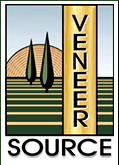







Use of Reclaimed Timber
Interest in timber salvaged or reclaimed from old logs cut from old growth forests has increased recently.
Logs harvested over 100 years ago and transported by water often sank en-route to mills. The resulting “lost underwater forest" lay on the bottoms of rivers and lakes until recently as proper environmental and mechanical procedures for retrieving them have been developed. Reclaimed submerged materials are utilized in all aspects of construction of fine furniture, architectural woodwork and musical instruments. Submerged lumber is generally processed in both solid lumber, plain sliced and rotary veneer. The uniqueness of the harvesting procedures, the high quality of the material and unusual aesthetic qualities are a few of
desirable traits associated with this special material. Some of the characteristics unique only to reclaimed submerged timber are:
- Greater density due to tighter growth rings than currently harvested stock;
- Beautiful variance of color gained from the transfer of mineral absorption found naturally in bottom sediments and water;
- Substantial increase of ease in milling due to sap replacement;
- Superior tonal qualities;
- A more pristine appearance;
- Aspects of Historical importance as well as environmental consciousness is added to any project;
- Complete use of the harvested resource.
Check availability and differences in aesthetic qualities before selecting.
Engineered Products
Structural Composite Lumber (SCL) — A man-made composite that utilizes grain oriented wood strands from a variety of tree species, providing an alternative to dimension lumber. The material is engineered for strength and stability. While SCL is not really “lumber," it is marketed as a lumber substitute. SCL can be specified as core, stile backers, and core for stiles and rails, so long as all other criteria of these Standards are met in relation to its use.
Factors Influencing Lumber Selection
- Æsthetics
- Availability
- Size Limitations
- Cost
- Strength, Hardness, Density
- Dimensional Stability
- Adaptability for Exterior Use
- Fire Rating
Hardwoods and softwoods are raw materials. They cannot be “graded" using the QSI terms Premium, Custom, or Economy Grade.
Note: Only Grades of workmanship and finished product are defined by the Quality Standards Illustrated (QSI) Grade designations: Premium, Custom or Economy. Hardwoods, softwoods and wood veneers are raw materials. Raw material grades, or properties, are defined by independently formulated grading rules. The grades of material defined and utilized in the QSI are Grade I, II and III, for hardwood and softwood lumber and Grades AA, A and B, for veneer face products. For the most part, the QSI requires that the grade of material corresponds to the QSI Grade of workmanship/product specified; i.e. Premium Grade must utilize Grade I and Grade AA. However, you may wish to define a higher, or lower, grade of material for aesthetic, or structural reasons. Opaque finishes usually use a lower material grade.
... that managed forests, thanks to their high proportion of young, strong, growing trees, enable CO2 to be extracted?
... that an old, unmanaged forest produces as much CO2 through processes of decomposition and decay as it stores, and that therefore an unmanaged forest contributes nothing to reducing global CO2?


The Veneer Source • 400B Pittman St, Orlando, FL 32801
Phone: 407-423-2252 • Fax: 407-423-1566 • sales@veneersource.com
Phone: 407-423-2252 • Fax: 407-423-1566 • sales@veneersource.com